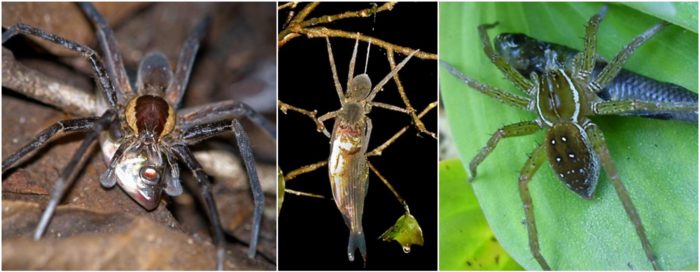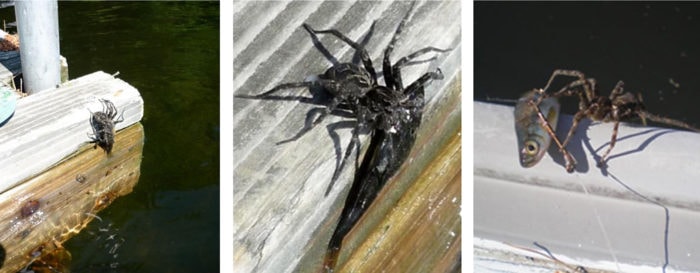Fishing spiders – nature’s creepiest success story

Bec Crew
Bec Crew

FOR MANY OF US, the idea that water itself is no escape from spiders is not great. They lurk in our bushlands, our gardens, our back sheds, our bedrooms – we’ve already got snakes to think about in the water, do we have to worry about spiders in there, too?
The short answer is, not really, because fishing spiders are far more interested in fish than they are in biting humans. The more complicated answer is yes, because my irrational fear cares not for your logic.
Regardless of how you feel about spiders existing in water, they’re there, and for once, we can’t just blame Australia for this nightmare. Fishing spiders are found on every continent on Earth, bar Antarctica.
Most of them belong to the Dolomedes and Nilus genera, which means fishing spiders aren’t impossibly tiny cuties à la jumping spiders. Nope, these are sizeable spiders – the leg-span of a female Dolomedes can stretch to as much as 9 cm long.
Fishing spiders spend most of their time at the water’s edge, camouflaging against rocks or foliage alongside shallow freshwater streams, rivers, lakes, ponds, and swamps.

Left: Dolomedes sp. preying on mountain galaxias in Queensland. Mid: A wandering spider (Ancylometes sp.) feeding in Peru. Right: Dolomedes triton feeding in garden pond in Florida, US. (Image credit: Loren Jarvis; Alfredo Dosantos Santillan c/o Amazonia Expeditions; Machele White)
Oh, and sometimes they’re found hauling their prey up onto the dock, as this unsettling series of photos from Canada and the US reveal:

Left and mid: Dolomedes scriptus feeding on a dock in Ontario, Canada. Right: A Dolomedes spider feeding on a mis-cast bait fish in Maine, US. (Image credit: Lloyd Alter; Jeffrey Hollis)
Dolomedes in particular are exceptional at swimming, diving, and walking on the water’s surface, which helps them to snatch and eat nutrient-rich meals of local fish species.
And these aren’t tiny baby fish – they can often be 6 cm in length, which is more than double the average fishing spider’s own body size (minus the legs).
No prizes for guessing where the biggest fish caught by a spider was from, because yep, it’s Australia.
According to a definitive paper on fishing spiders by biologists Dr Martin Nyffeler from the University of Basel in Switzerland and Dr Bradley J. Pusey from the University of Western Australia, the largest fish on record captured by a fishing spider was a goldfish in a garden pond in Sydney measuring 9 cm in length and weighing approximately 10 g.
In Australia, fish predation events have been witnessed in suburban gardens of Adelaide, Brisbane, Lismore, and Sydney, and there have been reports of fishing spiders hunting on the fringes of slow-flowing streams in New South Wales and Queensland.
One such species is Dolomedes facetus, found in eastern Australia, and cousin to the aptly named giant water spider (Megadolomedes australianus) which, just, ugh, I hate it.
I’ll finish up with a cute little fact to further cement this swimming spider nightmare – fishing spiders belong to the family Pisauridae, otherwise known as nursery web spiders.
When the mother spider senses that her eggs are about to hatch, she goes ahead and builds a nursery ‘tent’, into which she manoeuvres her ripening egg sac. She then stands guard atop the tent and, okay I’m done, this arachnophobe has had enough.
I’ll leave you with this delightful footage of an African fishing spider feeding on a frog:




